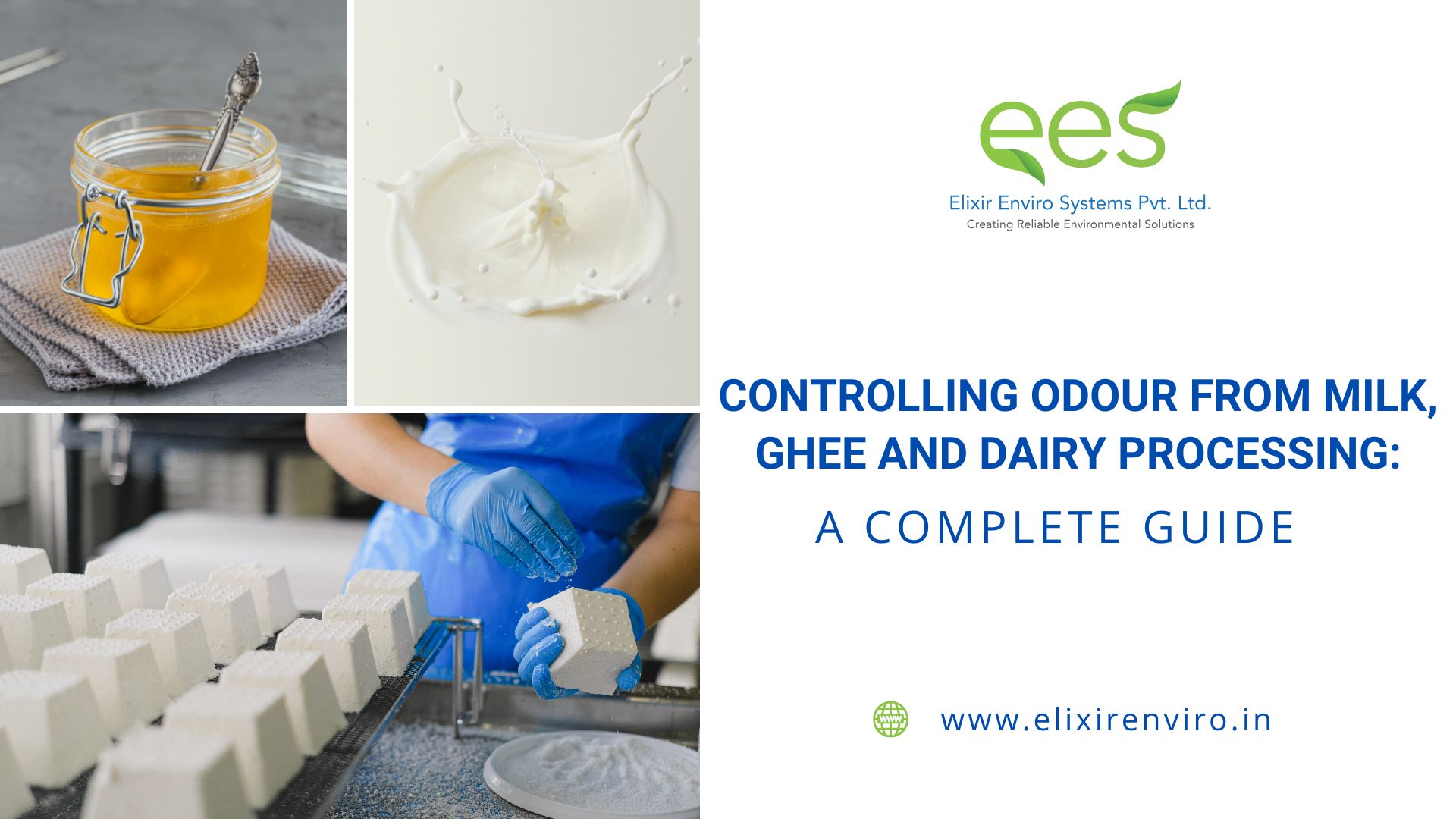
In the dairy industries maintaining a clean hygienic and Odour free environment is critical not only for regulatory compliance but also for employee health and brand image. From milk pasteurization to ghee carification, each stage in dairy processing can emit various smell that, if left unchecked can cause discomfort , environmental concerns and even neighbour complaints. This blog guides you to explore the cause of odour in dairy, milk and ghee processing plants and effective strategies to control and eliminate them.
Dairy processing involves the handling of large amounts of organic materials such as raw milk, cream, curd and butter, which are subjected to spoilage and fermentation. If not managed properly, the by-products of these processes can lead to the release of unpleasant smells. Here’s why odour control should be a top priority:
Understanding the sources of odour helps in deploying targeted solutions. Some of the most common odour sources in a dairy or ghee processing facility include:
Psychrophilic (bacteria with optimal growth rate below 15°C) and Mesophilic (bacteria with optimal growth rate between 20-40°C) bacterial growth can make the milk processing plant smell awful. This happens, If the milk is stored for extended periods at improper temperatures, it can ferment and can produce sour or putrid odours.
The heating of milk and cream releases volatile organic compounds (VOCs) that contribute to strong smells, especially during ghee production. Also improper processing like Overheating butter during clarification can cause burnt odours, while incomplete removal of milk solids can lead to spoilage-related smells.
Whey, a by-product of curd and cheese making, contains organic matter that decomposes quickly. Improper disposal leads to foul smells.
Milk spills or leftover residue on floors can rot and produce odour if not cleaned thoroughly.
Effluents containing milk solids, fats, and detergents from cleaning-in-place (CIP) systems can create anaerobic conditions, emitting hydrogen sulfide and other gases.
Managing odour in dairy processing plants requires a multi-pronged approach combining engineering, chemical, and biological controls. Here are some proven strategies:
Whenever possible, ensure that odour-generating processes like ghee clarification or cheese ripening are enclosed and equipped with fume extraction systems. Also its always better to use the enclosed crate washing units and so on to avoid the spillage milk speading all over and acting as a fugitive source of odour.
These eco-friendly systems use microbial activity to neutralize odours.
✅ Biofilters (Cocofil™ or Organic Media)
A mixture of coconut husk, compost, and soil traps and degrades VOCs biologically. These are perfect for continuous, low-concentration odour sources.
In this setup, odourous air is washed with water in a tower where bacteria are suspended. The scrubbing media absorbs odourous gas, and which is later transferred to an aeration-based treatment unit. At this aeration tank the microbes digest compounds like H₂S and ammonia and making it odourless compounds. This liquor is later circulated again in the absorption/scrubbing column to as a continuous system.
✅ Biotrickling Filter
In this setup, odourous air is passed through a column where the microbes are attached on a packing medium like in the trickling filter. Unlike trickling filter, which is used for wastewater treatment, here the case of biotrickling filter, air is being treated. Similar to that in the scrubber, the mass transfer of odourous2 compounds first happens from waste gas to the liquid that is being trickled over the media containing bacteria. Then the compounds gets taken up by the bacteria from the liquid and neutralize them.
All the above systems are low-maintenance, energy-efficient, and are highly effective for odour control.
Ideal for point-source odours with high gas concentrations. Here, odourous air is passed through a packed column or spray scrubbers where it reacts with acid/alkali solutions.
Used for ammonia control (uses acidic solution as scrubbing liquid)
Used for hydrogen sulfide and other acid gas control (alkaline solutions are used as scrubbing liquid).
Always include mist eliminators to prevent chemical carryover.
These are compact, plug-and-play systems that adsorb odourous gases using porous carbon media. Suitable for:
They offer high removal efficiency and minimal maintenance, making them a popular choice.
Instead of letting organic waste rot in open containers, convert it into compost or manage it through covered anaerobic digestion tanks.
Managing odour effectively starts with knowing when, where, and how it’s being released. One of the smartest ways to do this is by using real-time odour mapping and monitoring with advanced sensor technology.
By placing sensors and data loggers in key areas around the facility, plant operators can keep an eye on odour levels, spot unusual changes, and identify problem spots quickly. This steady flow of data helps teams take action early—before odour becomes a regulatory issue or leads to complaints from the community.
How Oizom Helps with Odour Monitoring
Oizom (www.oizom.com), a leader in environmental monitoring, provides innovative tools like Polludrone and Odosense to tackle odour challenges. These smart, IoT-enabled devices are designed to accurately detect a variety of odourous gases, including hydrogen sulfide (H₂S), ammonia (NH₃), methane (CH₄), and VOCs, giving operators the insights they need to stay ahead of potential problems.
In India and many other countries, dairy processing units—including those producing milk, curd, butter, and ghee—must adhere to stringent odour emission norms laid out by their respective Pollution Control Boards. The Central Pollution Control Board (CPCB) and State Pollution Control Boards (SPCBs) have specific environmental guidelines aimed at minimizing nuisance odours that can affect local communities. To stay on the right side of regulations, facilities need to run regular environmental audits, keep current records of their emissions and cleanup efforts, and work with certified experts in odour control. Why go through all that? Because staying compliant doesn’t just help avoid fines or legal trouble—it also builds public trust and shows that the company genuinely cares about the environment.
Elixir Enviro Systems is a leading name and pioneer in India in industrial odour control, providing end-to-end solutions that help dairy processing units stay compliant, efficient, and community-friendly. With extensive experience in managing odour emissions across diverse industries, Elixir offers specialized services tailored for dairies, milk processing units, and ghee manufacturing plants, where organic waste, fermentation processes, and effluent treatment systems often result in strong and persistent odours.
Our offerings include:
With over 1 million m³/hr of treated air capacity across India, Elixir Enviro Systems is the trusted partner for sustainable, scalable, and proven odour control in the dairy industry.
Odour control in dairy, milk, and ghee processing plants is not a luxury—it’s a necessity. Persistent odours don’t just affect your plant’s environment; they can compromise employee health, community relations, and compliance with environmental regulations. A proactive, well-engineered odour management strategy enhances operational efficiency, reduces legal risk, and strengthens your brand’s reputation.
Elixir Enviro Systems helps dairy processors take odour control from an afterthought to a core operational priority. With industry-specific expertise, cutting-edge technologies, and end-to-end support, we empower your facility to operate cleaner, safer, and more sustainably.
📞 Need help with odour control at your facility?
Partner with Elixir Enviro Systems to implement reliable, compliant, and sustainable odour control solutions tailored to your dairy operations.
👉 Contact us today
📧 Email: info@elixirenviro.in 🌐 Visit:www.elixirenviro.in
Foul odours can result from the fermentation of spoiled milk (raw material handling), heating of fats (processing), waste accumulation, whey disposal, and inefficient cleaning processes. Also, wastewater treatment plant collection tanks and headworks creates big odour nuisance issues. In many places, the emissions from the spray drying column also creates huge odour nuisance. In short, the odour from dairy can be the following places
Odour perception is subjective but measurable using sensory and instrumental techniques. Commonly detected smells in dairy operations include sour milk, rotten eggs (hydrogen sulphide), rancid butter, and ammonia-like scents. Odour monitoring includes both qualitative and quantitative approaches:
Several key compounds are responsible for malodour in dairy operations:
Operational changes can significantly reduce odour:
Use enclosed heating systems, make sure the area is well-ventilated, and use air scrubbers or odour-neutralizing products. Keeping the space clean and removing waste regularly also makes a big difference.
Yes, Biofilters, Biotrickling filters, Bioscrubbers and plasma ionization are sustainable, environmentally friendly options that effectively neutralize odours. Generally, the Biological systems such as Biofilter, Biotrickling filters and Bioscrubbers turns out to be the lowest lifetime cost system. Require low energy and offer high removal efficiency for H2S and VOCs
Key considerations:
Absolutely. Most environmental boards require odour management plans, and effective odour control helps meet these compliance standards




